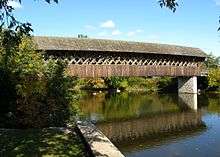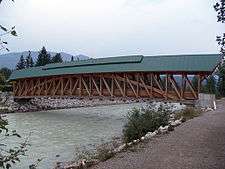Timber Framers Guild
The Timber Framers Guild (the Guild) is a non-profit, international, membership organization established in 1984 in the United States to improve the quality and education of people practicing the centuries-old art of Timber framing buildings with timbers joined with primarily wooden joints. Today the stated goals of the Guild are to provide "... national and regional conferences, sponsoring projects and workshops, and publishing a monthly newsletter, Scantlings, and a quarterly journal, Timber Framing "[1] The Guild is not like medieval guilds in that the emphasis is on education rather than control of this traditional trade. Similar organizations are the Carpenters Fellowship in the U. K., Compagnons du Tour de France in France, and Zimmerman in Germany (a German language site). The Guild is not directly associated with the United Brotherhood of Carpenters and Joiners of America. Originally the Guild was named the Timber Framers Guild of North America but the "North America" was dropped in recognition of the Guild's international presence.


Membership
Membership in the Guild does not necessarily reflect competency but an interest in learning and/or teaching. Membership is not required to practice timber framing. Most members build new timber frames, but many members restore, rehabilitate, preserve and/or study historic timber framed buildings. The philosophies vary widely with some members being innovative and designing buildings of the future, some use computer-controlled machinery to cut frames, some work only with traditional hand-powered tools. Some members use metal connectors rather than traditional wooden joinery.
Sub-groups within or associated with the Guild
- Traditional Timberframe Research and Advisory Group (TTRAG): Part of the Timber Framers Guild officially formed in 1990.
The TTRAG group produced survey guidelines for recording historic timber framed buildings.
- "The Timber Frame Engineering Council (TFEC) formed in 2005 at a Guild conference in recognition of the considerable number of structural engineers among the Guild membership and in response to a felt need for systematic research, discussion and codification of timber frame joinery and structural practices."[2]
The TFEC has developed a Standard for the Design of Timber Framed Structures as a "...supplement to provisions of the National Design Specification for Wood Construction..."[3] to assist engineers in this design specialty.
- Timber Frame Business Council: A non-profit organization focused on the business of timber framing.
Conferences
The Guild holds an eastern conference, western conference and TTRAG conference annually. Regional meetings, workshops and projects occur irregularly. For a list of past projects since 1988 see here.
Apprenticeship Program
The Guild has created a training program for apprentices to learn the art and science of traditional timber framing from mentors called journeyworkers. "Successful apprentices receive a nationally recognized credential registered by the United States Department of Labor under our program number NO152090893.[4] This program uses a formal curriculum which is still under development as of 2012.
Publications
The Guild publishes a newsletter for members, a respected journal Timber Framing, and books on the specialized topics of traditional timber framing. The Guild also lists other relevant books, software and a Glossary of timber framing terms. An important record of historic timber frame joints found in the U.S.A. is Historic American Timber Joinery: A Graphic Guide which was partially funded by a grant from National Park Service and the National Center for Preservation Technology and Training and thus are available for free download.[5] This guide is expanding as new types of joints are found and recorded.
Forum
An online, public forum is managed for anyone to search for past discussions or ask questions.[6]
See also
- Timber roof trusses
- Barn raising
- Pike pole
- Mortise and tenon
- Barn
References
- "Archived copy". Archived from the original on 2012-11-07. Retrieved 2012-12-02.CS1 maint: archived copy as title (link)
- "Archived copy". Archived from the original on 2013-09-20. Retrieved 2012-12-02.CS1 maint: archived copy as title (link)
- "Archived copy" (PDF). Archived from the original (PDF) on 2014-09-12. Retrieved 2012-12-02.CS1 maint: archived copy as title (link)
- "Archived copy". Archived from the original on 2013-02-26. Retrieved 2012-12-11.CS1 maint: archived copy as title (link)
- http://www.tfguild.org/downloads/publications/Historic-American-Timber-Joinery.pdf
- "Timber Frame Forums - Forums powered by UBB.threads™". forums.tfguild.net. Retrieved 17 April 2018.